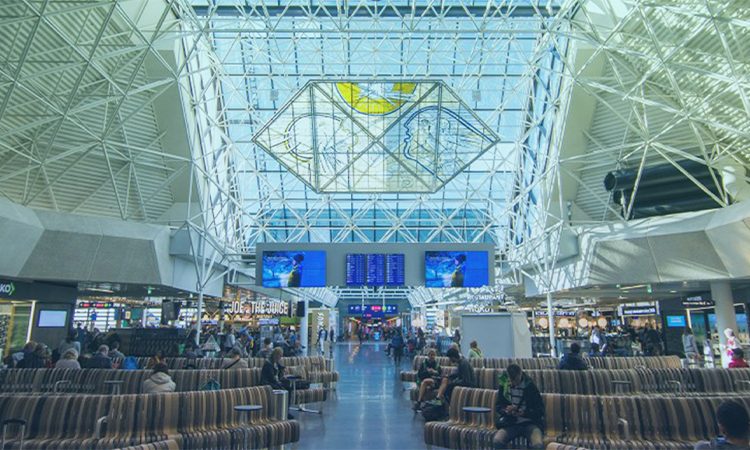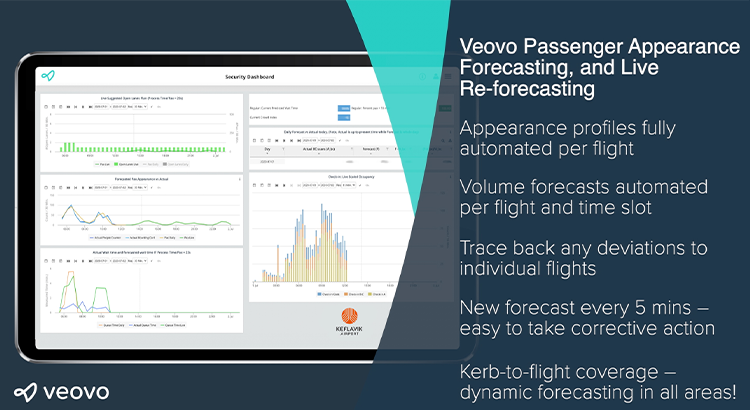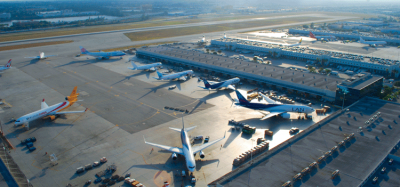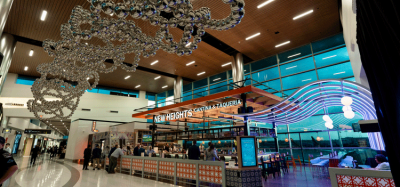How Keflavik International Airport is using dynamic forecasting to navigate the pandemic
- Like
- Digg
- Del
- Tumblr
- VKontakte
- Buffer
- Love This
- Odnoklassniki
- Meneame
- Blogger
- Amazon
- Yahoo Mail
- Gmail
- AOL
- Newsvine
- HackerNews
- Evernote
- MySpace
- Mail.ru
- Viadeo
- Line
- Comments
- Yummly
- SMS
- Viber
- Telegram
- Subscribe
- Skype
- Facebook Messenger
- Kakao
- LiveJournal
- Yammer
- Edgar
- Fintel
- Mix
- Instapaper
- Copy Link
Posted: 23 October 2020 | Veovo | No comments yet
KEF recently implemented a dynamic forecasting solution with unique live re-forecasting capabilities which became a vital tool in keeping operations running smoothly while dealing with three major issues.


In late-March 2020, Keflavik International Airport (KEF) saw an unprecedented and sudden drop in global air travel. The COVID-19 pandemic – coupled with fluctuating travel restrictions, evolving screening processes and spacing constraints – plunged airports into chaos.
At KEF, a recently-implemented dynamic forecasting solution’s unique live re-forecasting capabilities became a vital tool in keeping operations running smoothly while dealing with three major issues – volatile flight schedules, load factors and passenger presentation profiles. We asked Thordis Bjørnsdottir at Isavia how the solution has helped to reduce the impact of recent travel volatility and supports new distancing initiatives.
Why did you implement a new forecasting solution in the first place?
We experienced considerable success with Veovo´s Passenger Predictably technology, which gives us complete airport-wide passenger flow insights. These have helped us streamline multiple processes and reduce our manual forecasting workload significantly. Earlier in 2020, Veovo demonstrated the benefits of their new forecasting solution, including per-flight forecasting and live re-forecasting. We saw great benefit in adding this solution to our current Veovo system. At the time, we faced exponential growth in passenger numbers, and we felt that this addition would enable us to better match capacity with demand.
With the ongoing pandemic, how has this affected your forecasting and planning?
Naturally, the pandemic resulted in the exact opposite of the expected growth – numbers dropped. We had so many new variables to contend with, from travel restrictions to changing flight schedules, screening, cleaning and, of course, spacing constraints. Currently, even traveller behaviour is far from uniform. This volatility means that we cannot depend on plans based on pre-pandemic historical show-up patterns.
How does the solution help to reduce the impact of recent travel volatility?
It has proven valuable due to how rapidly situations change during these unforeseen times. The live re-forecasting capabilities provide an early heads-up on changes to passenger presentation profiles per flight. It always reflects and re-forecasts based on the current situation, allowing us to easily adapt plans and rosters, improving journeys and keeping costs down.
For instance, we were able to spot deviations in passenger show-up behaviour in our security control. Passengers were arriving later than usual due to COVID-19. Because of the immediate nature of the data, we were able to see the deviation between the forecast and actual, and react and adjust the forecast accordingly.
What does the solution do, in practice?
It draws data from multiple sources, including various sensor technologies, AODB, boarding pass scans and more. This creates an accurate by-flight picture of how our passengers move throughout the terminal. It allows us to forecast for days, weeks, even months ahead more accurately. As it continually re-forecasts, we are alerted immediately when predetermined thresholds are reached. Resourcing and operational actions are recommended to minimise bottlenecks and prevent crowding, for example, by adjusting call-to-gate time and changing border or control lane openings.
It also allows us to understand the cause of the deviation from the plan, which could be anything from a late arrival to a slower-than-predicted security process. This insight is then fed back into the future plan to continually improve forecast accuracy, based on local conditions.
Which unique features of the system have stood out to you?
Although the system is automated, by changing certain parameters, we can adapt the forecast, based on the current situation in the airport. For example, in late-August 2020, Iceland’s government implemented new COVID-19 regulations, following which the number of passengers dropped. Since the solution partially learns from historical data, we shortened the learning period to make the forecast more responsive to the new regulations.
We can test new KPIs quickly, assume process times and more, and compare these to plans that use different assumptions. We can easily adjust our forecasts by adding an unforeseen event to the calendar – for example, the implementation of new travel restrictions to specific destinations – which the system recognises and treats as unusual and unique. We have the opportunity, at any time, to create a new plan and compare it to the plan that is in production.
Live re-forecasting is, however, the most outstanding feature of the system. It continuously takes into account all variables of the current situation – such as queue length, scheduling, actual passenger counts and wait times – and compares them to the daily forecast. It then provides an updated passenger forecast and capacity plan every few minutes. By simply understanding how the actual situation deviates from expectation, we can almost instantly see the potential effects and mitigate these. Live re-forecasting provides the most accurate insights to make these decisions based on the right information.


In what ways has the system made your job easier?
The system is automatic and has been customised to accommodate our access to data and planning needs. It requires no manual work or any specialised skills to use, giving us more time for evaluation and adjustments to improve future plans. All forecast changes or adjustments that we have to make are accessible and easily managed in the system.
Also, we always get positive and quick responses from the Veovo team. Their attitude and level of service has been superb from the start. Changes or new ideas are always welcomed, and their input and knowledge are invaluable to us.
How does the forecast evaluation in previous systems compare to the new system?
Previously, evaluations were not very accessible and called for a lot of manual work. Data from multiple systems had to be collated into one Excel file before making the evaluation. We did not have much input on how the forecasts were produced.
Now, it is accessible and presented visually per flight, and we no longer need to gather data from multiple systems. We can compare our forecast against actual, and easily calculate the accuracy of the forecasts in whatever desired resolution, for instance, per hour, day, week, etc.
How easy is the sharing of information/plans/data with shareholders compared to previous systems?
The configurable dashboard makes information and data-sharing much easier. We can share dashboards, create reports or share future forecasts and “what if” scenarios. With partners like security, border control, retailers and ground-handling, we can create unique restricted accounts for specific data-sharing. They are also kept informed about passenger show-up and potential operational impacts.
The ‘new normal’ will likely look very different from pre-pandemic air travel. What ongoing challenges do you expect the solution to help solve?
More than anything else, the system has proven it can help us handle the most unpredictable and volatile situations efficiently and safely. This means that, even if a return to pre-pandemic occupancy is slow, we still see great expansion possibilities for our current forecasting solution. With our Kerb-to-Flight passenger flow management, we can forecast in all areas and processes throughout the airport. Setting up forecasting in a new area is quick and easy. Our next step will be to implement occupancy forecasting at duty-free and other open areas of the airport.
How does this solution help you assure passengers that they will be able to travel safely?
This system is a game-changer when adapting to the new normal. When situations are volatile and can change at a moment’s notice, we need to keep the planning window as short as possible. To make safe, accurate planning decisions, we must base them on live information. Thanks to the system’s ability to accurately reflect the current situation, we will be able to manage transport growth as the pandemic gets under control. These capabilities will help our visitors feel confident in the safety of air travel and accelerate the return to normal passenger levels.
Related topics
Airport crisis management, Airside operations, COVID-19, Passenger experience and seamless travel, Passenger volumes


















